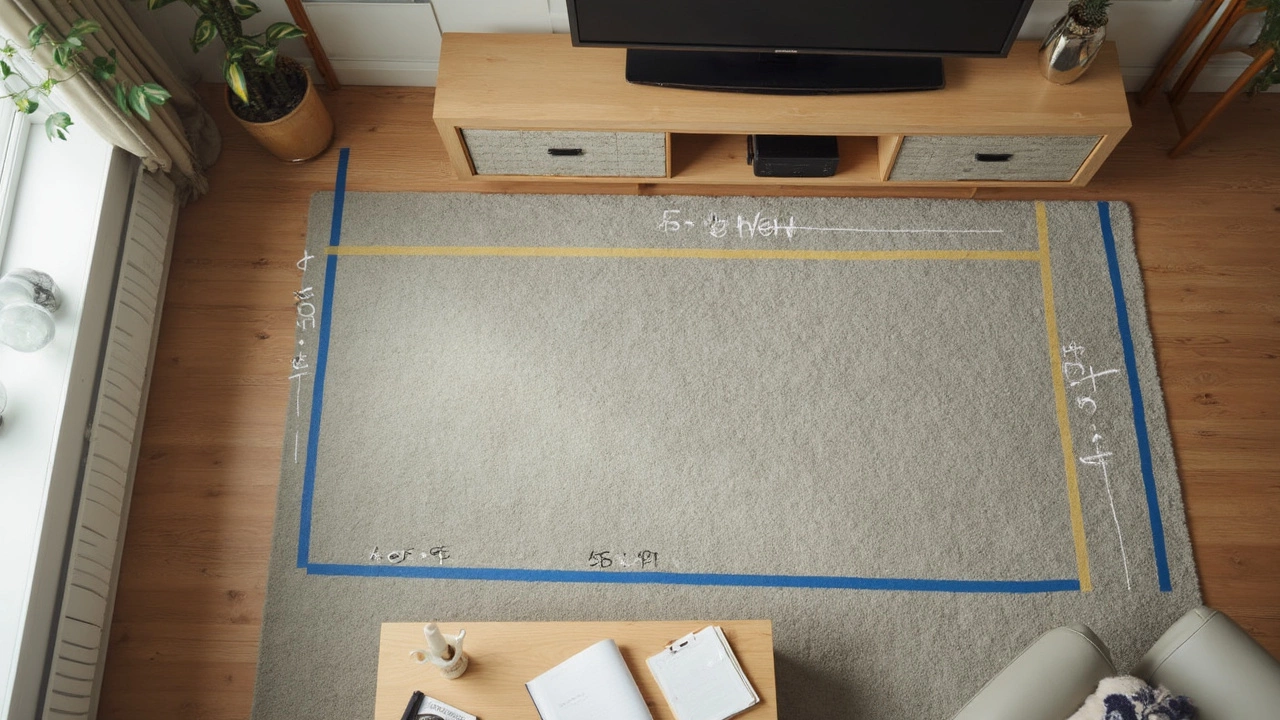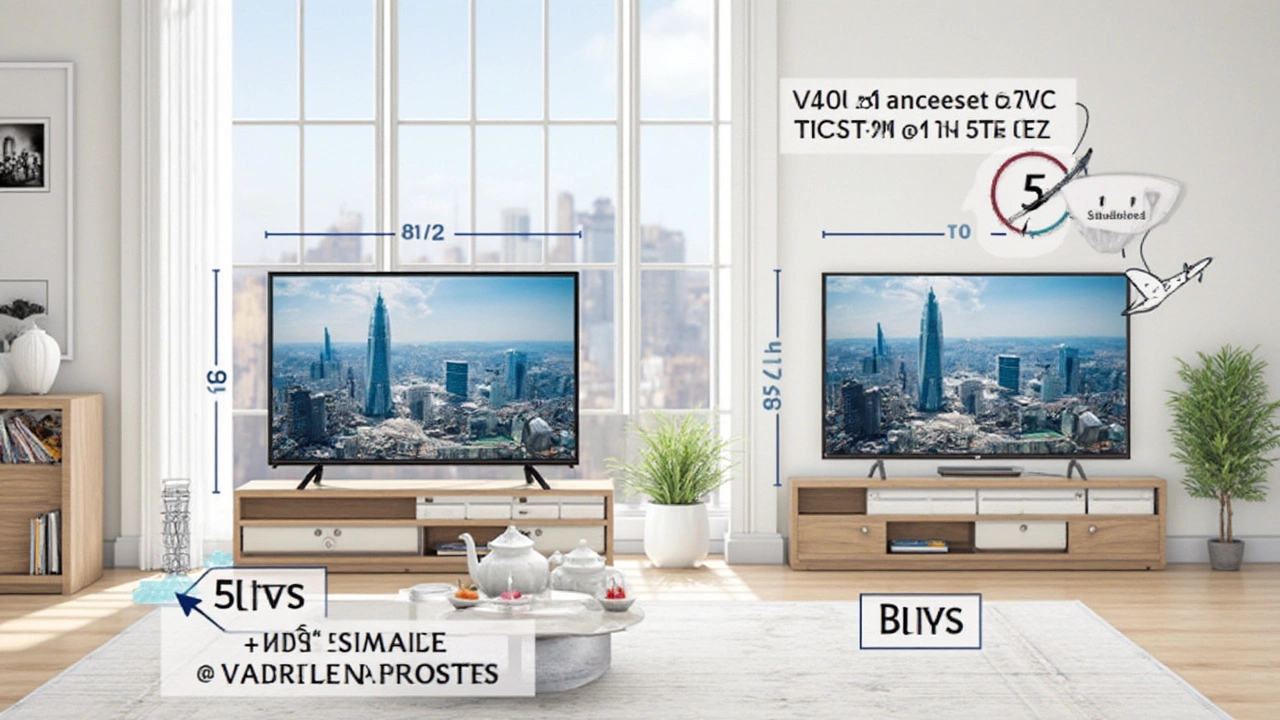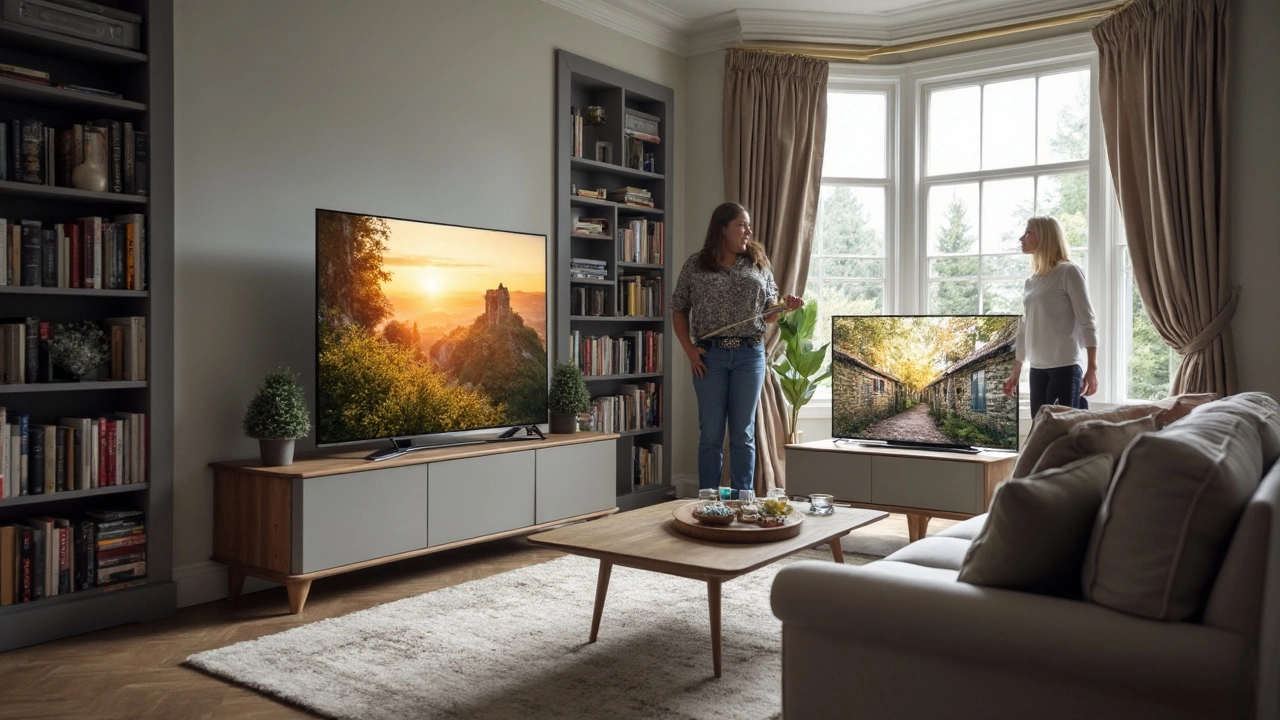Jumping from a 60-inch to a 65-inch TV sounds like a small upgrade—just five inches, right? Not quite. The number on the box is only the screen's diagonal length, and that five-inch bump actually means a noticeably bigger screen (and a wider TV that might not fit your current stand).
People often get caught off guard when they realize a 65-inch TV is not just a tiny bit bigger—it's more than 16% larger in screen area. That can change how you set up your living room or gaming space, especially if you already have a TV stand you love. Before you hit "Buy Now," let's break down exactly how much bigger a 65 really is over a 60 and what that means for your furniture options. This info can save you a headache—and maybe some extra cash on unneeded furniture upgrades.
- The Surprising Truth Behind TV Sizes
- Actual Measurements: 65 vs. 60 Inch TVs
- TV Stand Selection: What Really Fits
- Room Layout Considerations
- Tips for a Hassle-Free Setup
The Surprising Truth Behind TV Sizes
People hear "65-inch TV" and "60-inch TV" and picture just a few extra inches. Wrong! TV sizes are measured diagonally, not side to side. That small bump in the number can mean your new TV suddenly takes over your wall—or doesn't sit right on your current stand.
If you measure straight across the screen, a 65 inch TV clocks in with a diagonal of 65 inches. But what actually matters for your setup are the width and height. Here's a quick data breakdown you probably won't see on the store tag:
| TV Size | Width (inches) | Height (inches) | Screen Area (sq in) |
|---|---|---|---|
| 60 inch TV | 52.3 | 29.4 | 1,537 |
| 65 inch TV | 56.7 | 31.9 | 1,808 |
That means a 65 inch TV has over 270 extra inches of screen space compared to a 60. That's not just a small upgrade—that's room for another whole laptop screen, easy. This makes sizing up a lot more noticeable than most people expect.
Another thing? The TV frame (or bezel) is thinner these days, so most of what you see is pure screen. But don’t forget, the extra width might hang over the edge of an old TV stand. More surface area also means more weight, which could push a wobbly or narrow stand to its limit.
Manufacturers use diagonal numbers because, hey, bigger sounds better. But when you’re trying to match a 60 inch TV or 65 inch TV to your setup, pull out a tape measure and check if your furniture can actually handle the difference. A misstep here can turn an exciting TV upgrade into an annoying balancing act.
Actual Measurements: 65 vs. 60 Inch TVs
First off, don’t trust the “inch” part in 65 inch TV or 60 inch TV to tell you how wide or tall the screen really is. TV brands measure diagonally, which means corner to corner—not straight across. So the actual width and height are a bit of a math puzzle. Here’s what it breaks down to for most modern TVs:
- A standard 60-inch TV is usually around 52.3 inches wide and 29.4 inches tall.
- A 65-inch TV is about 56.7 inches wide and 31.9 inches tall.
That’s more than four inches of extra width—enough to poke off the sides of a too-small TV stand. And it’s taller, so you’ll see a chunk more screen when you sit down for a movie or the big game.
If you look at the screen area, here’s where it really jumps. A 60-inch TV gives you about 1,538 square inches of viewing area. A 65-inch TV clocks in at roughly 1,797 square inches. That’s an extra 259 square inches—basically, the size of a small computer monitor added onto your TV.
| TV Size (inches) | Width (inches) | Height (inches) | Screen Area (sq in) |
|---|---|---|---|
| 60 | 52.3 | 29.4 | 1,538 |
| 65 | 56.7 | 31.9 | 1,797 |
Don’t forget the frame (or bezel). These days, they’re thinner than they used to be, but some fancier models have a slightly thicker edge. Always check the actual measurements on the spec sheet before you buy, so you’re not trying to balance your new 65 inch TV on a stand that’s just a hair too small for comfort.

TV Stand Selection: What Really Fits
When you’re on the hunt for a new TV stand, the biggest mistake is thinking that an extra five inches on a TV doesn’t matter. For a 65 inch TV, you’ll need a noticeably wider stand than for a 60 inch TV. A 60-inch TV measures about 52.3 inches wide, but a 65-inch TV jumps to 56.7 inches wide. Doesn’t sound huge? That’s more than four extra inches, which can make your TV look awkward—maybe even risky—on a too-small stand.
The sweet spot for your TV stand? Go at least 2 to 8 inches wider than your TV. So for a 65 inch TV, look for stands at least 60 to 65 inches wide. If you push it with a narrower stand, the screen can hang over the edges, and trust me, that spells disaster with kids around (I’ve seen Elara nearly drag a controller cable before—yikes).
Here’s a quick size guide:
| TV Size | TV Width (Approx.) | Recommended Stand Width |
|---|---|---|
| 60 Inch | 52.3 in | 54–60 in |
| 65 Inch | 56.7 in | 60–65 in |
One of the leading TV furniture makers, Walker Edison, says:
"A good rule of thumb is your TV stand should be at least as wide as your TV, but ideally 2-3 inches more on each side for safety and style."
Don’t forget about the depth and height too. Thin, modern TVs don’t need as deep a stand as the old-school ones, but you still want at least 12–16 inches to fit the base and any extra gear. Match the height so the middle of your screen sits at eye level when you’re on the couch. If you like stacking gaming gear or soundbars, grab a stand with shelves or open compartments.
It’s easy to get swept up by the big screen hype, but a poor-fitting stand can ruin the look (and feel less safe). Double-check those measurements before you buy, and you’ll save yourself a lot of hassle down the road.
Room Layout Considerations
Here’s where a lot of folks trip up—a 65 inch TV doesn’t just stretch wider, it’ll likely demand some serious rearranging of your living room. If you’re upgrading from a 60 inch TV, the 65 inch will be about 4.4 inches wider and 2.5 inches taller. Sounds manageable, but small living rooms notice every inch. Measure your available wall space and don’t forget about the depth of your TV stand too.
Viewing distance is another biggie. The general rule for most modern TVs is to sit about 1.2 to 1.5 times the screen’s diagonal from the TV. That means:
- For a 60 inch TV: 6 – 7.5 feet away
- For a 65 inch TV: 6.5 – 8 feet away
Cramming a 65 right where your 60 lived could make things feel tight, especially if your couch can’t scoot back a bit. I learned that lesson after bumping knees on a coffee table every night for a week.
TV dimensions make a difference with corners and adjacent furniture, too. If your TV is going near a window or door, check that there’s enough room for both the stand and wires. Having to wedge your gear into a space never ends well,—and it looks awkward.
| TV Size | Width (inches) | Height (inches) |
|---|---|---|
| 60 inch TV | ~53.2 | ~29.9 |
| 65 inch TV | ~56.7 | ~31.9 |
If you’ve got a wall mount in mind, double check it’ll support the increased size and weight. Most mounts for a 60 will work with a 65, but older or basic brackets might tap out. Also, make sure the mount anchors line up with wall studs, especially if you’ve got little ones running around (Elara’s pulled some acrobatics that made me double-check our setup).
The jump from a 60 to a 65 is more than just numbers. Plan your layout right, and you’ll get a comfortable, safe, and instantly more impressive setup—without regrets or surprise trips to the hardware store.

Tips for a Hassle-Free Setup
Setting up a new 65 inch TV can be way easier if you plan ahead. Start by making sure your TV stand is wide enough—not just for the base, but for any side-to-side movement or cables. A 65-inch TV is about 57 inches wide, while a 60-inch is closer to 53 inches. That gap means your old stand might not cut it.
- Leave at least 2-3 inches of space on each side of the TV for airflow and safety, so look for a stand that's at least 60 inches wide for a 65 inch TV. If you want room for soundbars or decorations, go even wider.
- Double-check the weight. New TVs are lighter than older ones, but always check your TV stand's weight limit. Most modern TV stands list the max weight clearly—don't just eyeball it.
- Use a level and a measuring tape. Don't trust your eyes; measure to center your TV on the stand. A crooked setup leads to neck pain and complaints (trust me, my kid Elara will point out every little misalignment).
- Hide cords as much as possible. Simple cable management clips or sleeves work wonders, and they cut way down on dust bunnies behind the stand. You can even get stands with built-in cable channels to keep things tidy.
- If you're mounting your TV instead, hit the studs in the wall—don't just trust drywall anchors. For a 65-inch, you want at least two solid anchor points.
Here’s a quick data table for common TV and stand widths to make the shopping part less painful:
| TV Size (Diagonal) | Approx. TV Width | Recommended Stand Width |
|---|---|---|
| 60 inch | 53 inches | 56+ inches |
| 65 inch | 57 inches | 60+ inches |
Measure every piece twice before you start unboxing, and never rush the setup. If you take your time, you’ll avoid scratched screens, tippy TVs, and last-minute store runs. Plus, you get to relax and enjoy your new setup that much sooner.


Write a comment